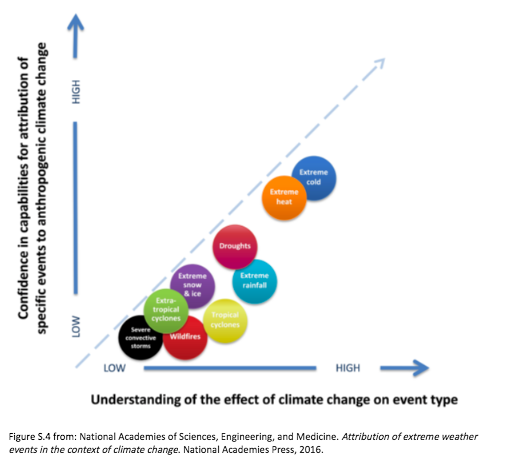My father was a statistician. After I took introductory statistics my fourth semester in college, I remember him saying he was glad that I could now appreciate that what he did for a living was more complicated than compiling the statistics I read each day in the sports pages.
While I did
not follow his career path, I have always been interested in how probability and statistics can be used to better understand our world. Hence, my interest in the field of “attribution science” and the ability of scientists to link climate change with occurrences of extreme weather.
The pa
st decade has seen a remarkable increase in interest and activity in extreme event attribution. The first attempt at attributing an extreme weather event to climate change was published in 2004—analyzing the 2003 European heat wave that killed tens of thousands of people.
In 2012, the American Meteorological Society (AMS) began publishing a special annual issue of their Bulletin, compiling articles on extreme weather events of the past year. From 2012 to 2015, the number of research groups submitting studies to this issue grew by a factor of five. This emerging area of science has drawn the public’s interest because of the frequently devastating effects of the events that are studied. Also, there is potential value of attribution for informing choices about assessing and managing risk and in guiding climate adaptation strategies. This could help guide rebuild or relocate decisions like what Ellicott City, Md., is doing now after having two devastating one-in-a-thousand-year floods, 22 months apart.
The ultimate challenge for the science of event attribution is to estimate how much climate change has affected an individual event’s magnitude or probability of occurrence. In terms of human influence, confidence in attribution findings is greatest for extreme events that are temperature-related, such as the observed long-term warming of the regional or global climate, where there is little doubt that human activities have caused an observed change.
The figure above illustrates the state of attribution science for different event types.
The horizontal position of each event type reflects an understanding of the effect of climate change on the event type. The vertical position of each event type indicates an assessment of scientific confidence in current capabilities for attribution of specific events to anthropogenic climate change for that event type. Extreme cold and hot events are the two event types for which the National Academy of Sciences has said that they have high confidence in event attribution science.
Key parameters in performing successful studies include the capabilities of climate models to simulate an event class, the quality and length of the observational record from a climate perspective, and an understanding of the physical mechanisms that lead to changes in extremes as a result of climate change. Attribution studies for droughts and extreme rainfall are noted as having medium confidence. There is less confidence in the attribution of severe convective storms and extratropical cyclones.
The ability to understand and explain extreme events in the context of climate change has developed rapidly over the past decade. We have moved past the time when we had to say that we cannot attribute any single event to climate change. In many cases, it is now possible to make and defend quantitative statements about the extent to which human-induced climate change has influenced either the magnitude or probability of occurrence of specific types or event classes. The science behind such statements has advanced a great deal in recent years and is still evolving rapidly. Further advances are needed though.
The latest AMS Bulletin (January 2018) Explaining Extreme Events of 2016 from a Climate Perspective, for the first time, presents three new research papers that conclude the extreme magnitude of a particular weather event was not possible without the influence of human-caused climate change. These include (1) a paper analyzing the 2016 heat record by NOAA scientists concluded that record global warmth was only possible due to substantial centennial-scale human-caused warming, (2) a study that found that the extreme warmth across Asia during 2016 would not have been possible without climate change, and (3) an analysis of a large, persistent area of anomalously-warm ocean water off the Alaska coast (aka the Blob) that found no instances of 2016-like anomalies in the pre-industrial climate for sea surface temperatures in the Bering Sea.
As advances are made in the data and models that are used to do attribution studies, the potential exists to provide valuable insights about where and how to make our streams and rivers more resilient to extreme weather, where and when to reintroduce trout, as well as where it may no longer be feasible to sustain trout habitat.
Jim Wilson is the former president of an environmental consulting firm and a TU volunteer from Virginia.



